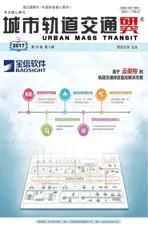Continued from Special Commentary
2017-03-25SUNZheng
Continued from Special Commentary
This concern is not unreasonable,because railways possess both commonweal and commerciality.Just because of considering the social welfare of railways,since 1995,in the case of railways’ financial difficulties,the ticket prices of our country’s ordinary-speed passenger trains still haven’t risen for 21 consecutive years.Although the high-speed rail’s construction and operation costs are much higher than the ordinary-speed railway’s,the essential attribute of the both is of the same.Therefore,it is impossible to determine the passenger fares of high-speed rail trains completely according to the construction costs.At present,China’s railways are dominated by commonweal in the national economy systems and escort for China’s economy.However,railways are also engaging in enterprise management,and they must consider their own benefits.
Then,are China’s high-speed rail train fares expensive? Now compared with the situations in the original countries of high-speed rail technology,such as Japan,France,and Germany,we would know a thing or two about it.The fare from Tokyo to Osaka on Japan’s Tokaido Shinkansen line is equivalent to RMB 1.6 yuan/km.The fare from Paris to Marseille on France’s high-speed rail TGV Southeast line is equivalent to RMB 0.94 Yuan/km.The one-way fare from Berlin to Frankfurt on German’s high-speed rail ICE line is equivalent to RMB 1.49 Yuan/km.And the second-class fare of China’s Beijing-Shanghai high-speed rail passenger-trains beginning with “G”is 0.42 Yuan/km.When comparing the two,although our country’s actual fare is lower,considering the gap between China’s average wage income and the economically developed countries’,China’s high-speed rail G-trains fare is still slightly higher.
According to the weighted average unit cost of high-speed rail in China published by a World Bank’s report,the 350 km/h project (for G-trains’ running) is 129 million yuan/km and the 250 km/h project (for D-trains’ running) is 87 million yuan/km.Referring to the proportion of both costs (G:D=1:0.67),if the second-class fare of the Beijing-Shanghai high-speed rail G-train is 0.42 Yuan/km,then the corresponding D-trains is due to 0.28 yuan/km.This provides a reference for adjusting the D-train fare.At present,the D-train fare of our country is 0.28 yuan/km,which is within the reasonable limit.
And let’s look at the pricing system of foreign countries’ high-speed rail trains again.Both Japan and Germany are to independently determine the high-speed rail train fares and the preference schemes by high-speed rail companies according to the market economy law.In France,the Government formulates a basic price for high-speed rail trains’ fares.This price is properly adjusted every year as the price index changes.Under the premise of not exceeding the basic prices,the railway company could issue various preferential prices based on market supply and demand conditions.Referring to these practices of foreign countries’ high-speed rail companies,it is suggested that under the premise of implementing maximum fares,China Railway Corporation and its affiliated railway enterprises should strive for passenger source through a flexible way of sales promotion.For example,they could sell various preferential tickets,such as student tickets,round-trip tickets,and senior-tickets etc.so that more lower-income people could share the comfort and convenience of high-speed rail,so as to fully reflect the railways’ commonweal.
In conclusion,China's high-speed rail fare adjustments should fully embody the unity of commonweal and commerciality,and follow in order and advance step by step in the ways and methods.Taking the fare adjustment of D-trains in the southeastern coastal area as an experimental unit is desirable because southeast coast is economically developed areas in China.And for those high-earners and business people,quickness and comfort is the first factors for them to consider,so they are relatively insensitive to fare rises or falls.In addition,our first high-speed rail line of absorbing social capital to construct is just in Zhejiang Province.Properly increasing the earning ratio on high-speed rail is to contribute to attracting more private capital into the high-speed rail area.Thus,it is conducive to the sustainable development of high-speed rail constructions.
(The original text,with “Pricing for High-speed Rail Should Take into Account Both Benefits and Public Welfare” as its title,was published on February 18,2017 in "Global Times".For this publication,the author has made a slight modification.)
(Translated by SUN Zheng)
